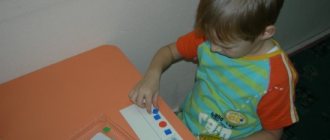A neuropsychologist is a specialist who studies (and is able, if necessary, to correct) the brain organization of all human psychological functions. In other words, based on knowledge of the patterns of development and functioning of higher mental functions, he is able to identify the causes of disorders or delays in development and plan a system of classes to “pull up” lagging functions.
The concept of neuropsychological diagnostics and its goals
Neuropsychological diagnostics is the process of studying the state of the brain, the characteristics of memory, attention, thinking and other mental processes of the individual to identify disorders and correct them. The diagnostician gives a set of tasks and observes the patient. The process also uses hardware methods.
During such an examination, it is possible to identify: features of the functioning of brain areas and foci of pathologies that can be directly related to difficulties in behavior, character, learning, and communication.
Scientists using neuropsychology are trying to solve many problems:
- restoration of brain function and memory in older patients and patients who have suffered a stroke or injury;
- correction of manifestations of pathologies of brain activity in children;
- improve the brain activity and behavior of people with autism spectrum disorder.
Who is hosting the reception?
The reception is conducted by the director of the center, neuropsychologist Olga Aleksandrovna Alexandrova. She is also a clinical psychologist and a licensed Tomatis® practitioner.
Alexandrova O.A. studied at the Institute. V.M. Bekhterev, regularly attends new courses and seminars to improve her skills.
If you are interested in neurocorrection, sign up for a consultation with a neuropsychologist by phone or fill out the application form on our website.
What does a neurospecialist diagnose in adults and children?
Depending on the age of the patient, diagnostic methods will be different, because in adults the brain is already formed, while in children it is just going through a period of development.
When examining an adult, a neuropsychologist will state in his conclusion a deficiency or damage to certain parts of the brain or the cerebral cortex. When working with a child, the degree of formation of brain zones is examined, although sometimes at a young age deviations from the norm of brain stem formations are discovered.
Neurodiagnostic methods
Basic diagnostic tests for adults were developed during World War II through research conducted in hospitals. In the classical approach, the neuropsychologist gives the patient tasks that help assess the functions of perception, memory, speech, hearing, vision, reading, counting skills and others.
However, if a three-year-old non-speaking child has neuropsychological difficulties, this method will not produce results. Therefore, psychologists use individual diagnostic techniques for each specific case, depending on the patient’s age, mental dysfunction and final objectives.
Two groups of diagnostic methods are usually used.
1. The first group includes research to obtain knowledge:
- a comparative anatomical approach that studies the interdependence of the brain structure and nervous system with behavioral characteristics and the environment of existence;
- a destructive method in which a specialist “turns off” part of the patient’s brain and analyzes behavioral changes;
- a stimulation technique in which pinpoint areas of the brain are exposed and the accompanying reaction is observed.
2. The second group of methods is the use of scientific approaches and hardware diagnostic capabilities to correct disorders (behavior, lost functions, slow development):
- electroencephalography;
- MRI;
- research using chemical indicators;
- PAT;
- CT.
Authors:
neurologist Mark Sandomirsky and neuropsychologist Ekaterina Lebedeva
Neuropsychotherapy is a new approach to solving psychotherapeutic problems. Until recently, he was known mainly abroad. Now in Russia a universal method has been created, registered and is successfully developing, which is part of this group of psychotherapeutic assistance. It is called “Neuropsychological Psychocorrection” (NPPC) and is gaining more and more supporters among Russian psychotherapists.
Neuropsychological correction (NPC) in Russia is known mainly in connection with children's psychological practice associated with disorders of psychomotor and cognitive development. The staff of our center stood at the origins of children's neuropsychological correction, introduced this method, tested, expanded and disseminated knowledge about neuropsychology and neuropsychological assistance to children. It can be said without exaggeration that the well-known method of Replacement Ontogenesis (co-authors: Arkhipov B.A., Semenovich A.V.) has gained fame and earned trust, including thanks to the dedicated work of the staff of our center, along with where Anna Vladimirovna worked and - leader V.S. Kolganova. From the point of view of the neuropsychological approach, disorders of psychomotor and cognitive development are caused by dysfunction of a number of brain structures that arose during pregnancy and the first year of life. The essence of corrective measures is to restart functions that have not fully formed and form adaptive connections between different areas of the brain in accordance with the course of normal ontogenesis.
However, from a psychotherapeutic point of view, the potential range of possible use of NPC is significantly wider, since the mechanism of action aimed at eliminating and compensating dysontogenetic problems is nonspecific. In a general sense, neuropsychological correction is a reflexive psychocorrective effect on the brain mechanisms of psychological maladjustment. Therefore, first of all, it can be used in the treatment of psychosomatic diseases and borderline neuropsychiatric disorders, both in children and adults. Also, CPD can be combined with various methods, as a nonspecific resource part of therapy, creating optimal functional states for therapeutic changes, so to speak, its neurological foundation .
R&D is developing as a comprehensive direction at the intersection of a number of disciplines.
a) On the one hand, it refers to behavioral neurology, which studies the neurological foundations of the ontogenesis of the psyche and dysontogenetic disorders (cognitive-behavioral, personality) and ways of their correction.
b) On the other hand, CPD is one of the areas of physiologically oriented psychocorrection, which in English literature is called neuropsychotherapy.
c) Technologically, many CPD techniques can be attributed to the so-called “occupational treatment”. This is not only treatment, but also rehabilitation/readaptation of adults and habilitation of children.
d) Another look at CPD lies in line with the direction of “developmental treatment”. This is a set of measures aimed at eliminating defects in ontogenesis due to reflex restructuring of the brain.
Since such neuropsychic development occurs throughout life (and not just in childhood), it can be therapeutically induced in pathological conditions and in adulthood.
Use of CPD for adults
Wherever non-verbal techniques are used in psychotherapeutic methods, elements of CPD are present only in an “undeclared form”. Using standard exercises, the normal sequence of sensorimotor development of a child is reproduced from the formation of basic reflex mechanisms in the prenatal period, and then through the consistent mastery of the skills of fixing the gaze, turning the head, crawling, standing up and walking independently by the beginning of the second year of life. This is not only the mastery of movements and the formation of a body diagram, but also the development of coordination and operation of space, including awareness of both spatio-temporal and cause-and-effect relationships, and the beginning of the formation of subjectivity.
All of the listed elements are interconnected, since the principle of a reflex “relay race” is laid down in ontogenesis: the stages of psychomotor development, replacing each other in a given sequence, trigger the maturation of more and more new reflex programs by already mastered reflexes. Similar mechanisms represent the reflex basis for the creation of psychotherapeutic trance states. Induction of trance always occurs according to the principle of physiological regression, as a repetition of ontogenesis.
Among the specific technological methods for inducing therapeutic trances, the following can be listed, in ontogenetic order:
1. Regression to the prenatal period: relaxation, sensory deprivation. In a broad sense, any trance induction associated with the autization of the sensory sphere.
2. Regression to the intranatal period. In a narrow sense, it is the reproduction of experience associated with the psychological “trauma of birth”, for example in holotropic therapy and therapy by A. Yanov. In a broad sense - any emotional stress therapy.
3. Regression to the early postnatal period. Relaxation, trance catalepsy.
4. Regression to the late postnatal period. Imitation of motor and nonverbal communication stereotypes of a child in the first years of life.
Application of CPD for children
As for the use of CPD in pediatric practice for cognitive-behavioral dysontogenetic disorders, the objective basis of the method is associated with the high ability of the child’s brain for reflex restructuring - the plasticity of the child’s brain and sensitivity (specific susceptibility in assimilation of information). The principle of replacement ontogenesis used in the process of correctional work, according to A.V. Semenovich includes the child’s performance of physical actions characteristic of earlier stages of ontogenesis, for example, in the field of psychomotor development - mainly associated with the first year of life. The goal is a repeated, time-compressed and more conscious “living” of deficient episodes of age-related development and replenishment of the experience necessary for the restructuring of reflex connections. In this case, the reproduction of functional states characteristic of age occurs due to physiological (and not biographical) age regression. It allows you to recreate for a short time the sensitivity inherent in the corresponding stages of ontogenesis in order to “re-live” and utilize artificial periods of sensitivity during the correction course.
As for expanding the range of application of CPD techniques for children , it is also indicated in complex psychotherapy of childhood psychosomatic disorders, since in connection with the age-related characteristics of the child’s emotional response, namely the somatization of emotions, this problem is very relevant. It is necessary to introduce relaxation-trance techniques into CPD programs. They create an optimal functional state for the effective implementation of a correction program.
Thanks to the trance-like increase in brain plasticity and the formation of artificial sensitive periods, the physiological base (“soil”) is prepared on which the instilled cognitive and behavioral skills should take root, since the underlying reflex mechanisms naturally play a large role in the cognitive and emotional development of the child. Associated with them is the mechanism of formation of the child’s consciousness as “joint knowledge” with the surrounding adults.
Also important in children's psychocorrection is trance “model training ,” since it allows the child to “absorb” self-regulation skills from adults. The mandatory involvement of parents (preferably mother) in the correction process is therapeutically useful. The empathic component allows us to partially compensate for the lack of empathy in parent-child relationships. It is one of the most important mechanisms of psychological and psychosomatic disorders in children. The effectiveness of empathic psychocorrectional influence increases significantly if the empathic “message” is expressed not only verbally, but also non-verbally, with the help of bodily emotional anchors, relying on psychobiological mechanisms of the symbiotic level.
In general, given the massive prevalence of those cognitive-behavioral and psychosomatic problems in children that CPD effectively helps solve, their significance on a societal scale, in its expanded version, supplemented by empathic and relaxation techniques, should be the subject of social psychotherapy programs, including for organized contingents of children - in schools and preschool institutions.
Thus, elements of CPD are incorporated into various psychotherapeutic technologies as regression reflex tools. The standard CPD repertoire can be effectively supplemented with new techniques that arise at the interface with psychotherapy: empathic communication (both verbal and non-verbal) and trance techniques (formal physiologically-oriented trance induction), communicative resonance, work with non-verbal resources (bodily, figurative) .
Such interpenetration of methods in order to increase efficiency, if carried out purposefully, can lead to their further integration on a unified basis, both neurophysiological (the principle of psychobiological determinism) and ontogenetic (the principle of development). At the same time, new neuropsychological technologies are called upon to contribute both to the practical tools of psychotherapy, in terms of objective, reflexive psychocorrectional techniques, and to its methodological arsenal.
From this point of view, modern objective psychotherapy, or neuropsychotherapy, is precisely neuropsychological therapy. (see Report at the PPL conference. Sandomirsky M.E., Lebedeva E.S.)
Mark Sandomirsky. "Elements of neuropsychotherapy."
Neuropsychotherapy is the objective basis of psychotherapy
“Today, many methods of psychotherapy dispute primacy - and although they all help people equally, they explain this in completely different ways. At the same time, trying to move from a private method of therapy to a general solution to human problems, they confuse themselves even more - they do not see the forest for the trees. And some don't even try to explain what they are doing, working blindly. Some will be content with vague explanations, such as: “thought is material”, or “processes occur at the cellular level”; without putting any real content into these common words.
And it exists, and in a universal language, common to all methods of psychotherapy - the language of psychophysiology. More precisely, that applied area of this fundamental science, which represents the objective basis of all psychotherapeutic methods - neuropsychotherapy. This direction, which has taken shape in recent years, is a modern continuation of the ideas of V. M. Bekhterev, put forward more than a century ago. And today - neither more nor less than the main direction of development of psychotherapy of the century, giving impetus to the development of all its classical private methods.
Yes, in fact, there are brain mechanisms for the occurrence of psychological problems and psychosomatic disorders, largely related to the unnaturalness of the modern lifestyle, which contradicts the instinctive nature of man. Consciousness and subconsciousness, repression and regression, trance induction and transformation, rejuvenation and artificial sensitivity - all these phenomena have a clear neurophysiological manifestation. Not only the meta-model or Ericksonian trances are initially embedded in brain programs and the laws of mental development (in fact, this is precisely why they work) ... but also any other therapeutic techniques, from conservative psychoanalysis to new-fangled constellations, have their own objective basis - which is what you and It remains to be seen in practice.”
Reliance on instincts in bodily psychotherapy
“As you know, all the problems of patients, despite their diversity, come down to several basic, existential ones (crystallization according to V.V. Makarov). From an objective point of view, the latter are associated with the improper functioning of the mechanisms of human basic instincts:
1. self-preservation
2. procreation
3. group membership
4. life purpose (meaning)
In age development, the first and second correspond to the Freudian oral period, the third to the anal period, and the fourth to the Oedipal period. Then this cycle repeats. Physiologically, instincts form a harmonious vertical hierarchical system, lining up from bottom to top in the listed order. And it turns out that problems at the bodily level are “tied” to certain levels in the hierarchy of instincts. Accordingly, help in solving problems is possible due to the redistribution of excitation in the nervous system (in TOP - “energy”) from one level of instincts to another. This universal therapeutic mechanism is called hierarchical instinct substitution.
For example, physical illnesses and psychosomatics can be associated with a violation of the instinct of self-preservation, and transfer of excitation in therapy is possible to the level of the procreation instinct or vice versa (as happens in yoga, qigong and Freudian catharsis). Problems with the procreation instinct can be eliminated by transferring excitation to the level of the group instinct (sublimation according to Freud). And the violation of the group instinct is resolved without conflict at the top level of the pyramid of instincts - the instinct of life purpose. In each specific case, you can select the appropriate bodily “anchors” and teach a person to use them independently to create and maintain the correct physical and emotional state. Thus, relying on instincts becomes an effective tool for bodily psychotherapy and self-regulation. This can be used in both individual and group therapy.” From the book “Elements of Neuropsychotherapy” by Mark Sandomirsky.
__________________________________
When copying or using materials, a link to the source is required
Stages of neuropsychological examination and its duration
Neuropsychologists build their work in stages:
- put forward a hypothesis, taking into account the medical history and conversation with the patient;
- prescribe examination methods;
- check the initial hypothesis as the patient performs tasks;
- isolate the syndrome;
- draw up a neuropsychological report and a plan for further correction.
A professional in this field must be able to quickly and competently make all the necessary decisions, so the examination is carried out in a capacious format and does not take more than 90 minutes for adults and 40 minutes for children. The duration of diagnosis depends on the patient’s age and health status. If the patient is tired, the neuropsychologist should interrupt the examination, because fatigue has a bad effect on brain activity and can significantly distort the accuracy of the results.
How does a neuropsychologist work?
Correction methods in neuropsychologist classes mainly include some physical and intellectual exercises. Therapy is carried out without the use of medications.
It is obligatory to examine the child at the initial stage of classes. Diagnostics does not require hardware tests; it is completely safe for the child. Children are offered various tasks - complete a drawing, remember the sequence of objects, words, put together a picture, etc.
Among other things, the peculiarities of the course of pregnancy, childbirth and child development are clarified. Based on these data, the specialist draws conclusions about the cause of the existing violations and proposes a plan for corrective training.
The duration of the work depends on the complexity of the problem, the age of the child (as you know, the earlier a violation is noticed, the easier it is to correct it) and other factors. Sometimes assignments are given to complete at home.
Who needs to undergo neuropsychological diagnostics?
The main goal of the examination is to determine the damaged brain link in an adult or to identify the cause of disturbances, delays or asynchrony of development in a child. Therefore, it is strongly recommended to consult a neuropsychologist for the following diagnoses (or suspicions of them):
- adults with disorders after a stroke, injury, tumor or its long-term treatment;
- children with mental retardation, speech, hearing and motor functions, autism spectrum disorder, reading, writing, counting disorders, hyperactivity disorder and attention deficit disorder, with consequences caused by injury, tumor or stroke.
Low academic performance, unsociability, inattention, inability to concentrate or sit in one place at the age of 4-11 years should also alert parents. Perhaps the child simply cannot behave differently due to the characteristics of the brain and needs correctional help from a specialist.







